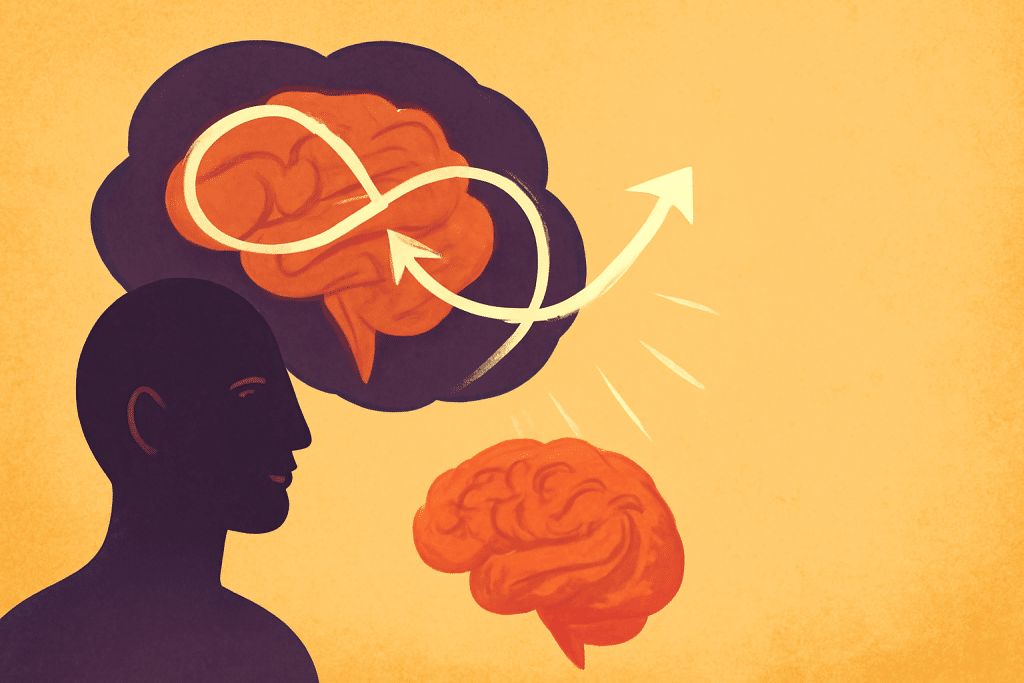How Thought Loops Become Breakthroughs
Natalie Brooks July 29, 2025
In the world of health and wellness, the idea that our thoughts can impact our physical and emotional well-being is gaining more traction. Thought loops—those repetitive cycles of thinking—can either create roadblocks or become powerful tools for breakthroughs, particularly in the realm of holistic health. This article explores how understanding and managing thought loops can lead to profound changes in our health, wellness, and overall life quality.

What Are Thought Loops?
Thought loops refer to patterns of repetitive, often self-perpetuating thoughts that can either help or hinder personal growth and well-being. In a positive context, thought loops can guide us toward new insights and breakthroughs. However, when these thoughts are negative or self-critical, they can create mental blocks that contribute to stress, anxiety, and even physical illness.
Understanding how these loops work and recognizing when they are hindering progress is the first step toward transforming them into something beneficial. In holistic health, it’s understood that the mind, body, and spirit are interconnected, and disrupting negative thought loops can open doors to healing and growth.
The Mind-Body Connection in Holistic Health
One of the central tenets of holistic health is the idea that the mind and body are intimately connected. The mind isn’t just a passive observer of the body; it actively shapes how we experience our physical health. Research continues to show that mental states can have profound effects on physical health.
The Impact of Thought Loops on Physical Health
Negative thought patterns can affect the body in various ways. Chronic stress, for instance, triggers the “fight or flight” response, releasing cortisol. Over time, this can lead to inflammation, weakened immunity, and conditions like heart disease. These physical effects often stem from negative thought loops the body struggles to break free from.
On the other hand, positive thought loops—those that focus on self-empowerment, healing, and growth—can lower stress levels, boost immune function, and increase the body’s ability to heal itself.
Transforming Negative Thought Loops into Health Breakthroughs
Recognizing and Interrupting Negative Thought Loops
The first step in transforming a negative thought loop into a health breakthrough is recognition. Often, we don’t even realize we’re stuck in a cycle of self-defeating thoughts. These loops can manifest as:
- Self-doubt: Thoughts like “I can’t do this,” or “I’ll never be healthy.”
- Fear: The constant worry about health problems, chronic conditions, or a fear of failure.
- Self-criticism: Negative self-talk, such as “I’m not good enough” or “I don’t deserve to be healthy.”
These negative loops feed into stress, anxiety, and even depression, blocking us from achieving true wellness. The good news is that interrupting these thought patterns can lead to profound improvements in both mental and physical health.
Practical Steps to Interrupt Thought Loops
- Mindfulness Meditation: By practicing mindfulness, individuals can become more aware of their thoughts without getting caught up in them. Meditation encourages a present-centered awareness, which allows us to recognize when we’re in a negative thought loop and gently guide our focus elsewhere.
- Journaling: Writing down your thoughts can help externalize them. Journaling is a powerful tool for breaking free from repetitive thinking. By identifying the root causes of the negative thought loop, individuals can begin to reframe their thoughts and shift them toward more constructive patterns.
- Cognitive Behavioral Therapy (CBT): CBT helps individuals recognize, challenge, and change negative thought patterns. This therapeutic approach teaches people how to break free from destructive thought loops and replace them with healthier cognitive patterns.
Embracing Positive Thought Loops for Healing
Once negative thought loops are interrupted, the next step is to consciously embrace positive thought patterns that support holistic healing. The key is to replace self-doubt and fear with thoughts that empower us to take charge of our health and well-being.
How Positive Thought Loops Lead to Health Breakthroughs
- Gratitude Practices: Research shows that cultivating gratitude through daily practices can positively impact both mental and physical health. Gratitude helps shift focus from what’s lacking to what’s abundant in life, creating a powerful cycle of positive thinking. When applied to health, this shift can motivate individuals to appreciate their body’s strengths and work on areas that need improvement.
- Visualization: Visualization is a powerful technique often used in holistic health practices. By imagining your body healing, feeling vibrant, and thriving, you can create a mental blueprint for your well-being. Positive visualization engages the subconscious mind, reinforcing the idea that health and vitality are achievable.
- Affirmations: Repeating positive affirmations, such as “I am healthy,” “I am strong,” and “My body is capable of healing,” can help rewire the brain. Over time, these affirmations can break the cycle of negative self-talk and replace it with a mindset focused on healing and growth.
The Role of Holistic Practices in Thought Loop Transformation
Holistic health practices not only focus on the mind but also engage the body and spirit. They are designed to work synergistically with mental and emotional practices, supporting the overall well-being of an individual. By incorporating these practices into daily life, individuals can further reinforce positive thought loops and accelerate healing.
Yoga and Mindful Movement
Yoga is a holistic practice that combines breath, movement, and mindfulness, making it a powerful tool for transforming thought loops. Through physical postures and mindful breathing, yoga helps release tension from the body, alleviating the physical effects of stress. As the body becomes more relaxed, the mind follows suit, and negative thought patterns become easier to release.
Yoga also promotes mindfulness, allowing individuals to become more aware of their thoughts and emotions. This awareness is the first step toward breaking free from thought loops and achieving breakthroughs in health.
Herbal and Nutritional Support
Herbs and nutrition play an important role in holistic health by nourishing the body and supporting mental clarity. Some herbs, such as ashwagandha and valerian root, are known for their ability to reduce stress and calm the mind. Nutrient-dense foods, such as leafy greens, berries, and fatty fish, provide the necessary building blocks for a healthy brain, supporting mental health and well-being.
Incorporating these practices into your routine can create a foundation for healthier thought patterns and greater emotional resilience.
The Science Behind Thought Loops and Health Breakthroughs
Neuroplasticity: The Brain’s Ability to Change
One of the most exciting aspects of working with thought loops is that the brain is highly malleable—a concept known as neuroplasticity. Neuroplasticity is the brain’s ability to reorganize itself by forming new neural connections in response to thoughts and experiences. This means that by consciously changing the way we think, we can rewire the brain to create healthier thought patterns.
Studies have shown that practicing mindfulness and positive thinking can physically alter brain structures, enhancing emotional regulation, memory, and overall well-being (Davidson & McEwen, 2012). By interrupting negative thought loops and replacing them with positive ones, individuals can actively foster neuroplastic changes that support holistic health.
The Power of Belief in Healing
The placebo effect is another powerful example of how thought loops can become breakthroughs in health. When people believe that a treatment will work—even if it’s just a sugar pill—they often experience real health improvements. This demonstrates the incredible power of belief and positive thinking in physical healing.
By cultivating belief in our own healing potential, we create the foundation for breakthroughs. Thought loops are not just mental phenomena; they have real physiological effects on the body.
Conclusion
Thought loops are more than just repetitive patterns of thinking—they can become powerful drivers of health and well-being when understood and managed correctly. In holistic health, the mind-body connection plays a central role in creating a healthier, more balanced life. By interrupting negative thought loops and fostering positive ones, individuals can unlock profound health breakthroughs.
The process of transforming thought loops requires awareness, patience, and practice. Whether through mindfulness, journaling, or holistic health practices like yoga and nutrition, the journey toward mental and physical wellness begins with the thoughts we cultivate.
By embracing the power of thought loops, we can create a future of health that is not only possible but transformative.
Reference
- Social influences on neuroplasticity: stress and interventions to promote well-being, https://www.nature.com
- Information-Seeking, and Emotional Health, https://pmc.ncbi.nlm.nih.gov
- Curiosity and well-being, https://www.researchgate.net







